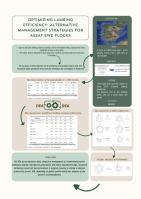优化产羔效率:Assaf母羊群的替代管理策略
IF 1.9
3区 农林科学
Q2 AGRICULTURE, DAIRY & ANIMAL SCIENCE
引用次数: 0
摘要
西班牙是欧盟领先的羊奶生产国,其特点是不同地区和品种的生产系统种类繁多。实现生产效率对于确保羊场的经济生存能力至关重要,特别是在条件较差的地区。目的以产羔及其影响因素为基本参考要素(决策单元:DMU),对绵羊养殖业管理效率进行评价。方法采用数据包络分析(DEA)方法对不同耕作制度的效率进行评价。我们分析了2474只不同年龄的Assaf奶牛母羊,收集了研究农场的生产和经济数据。考虑的变量包括挤奶期间使用的浓缩饲料百分比、产羔期、产羔间隔、休息日、产羔日龄、每只母羊的羔数、遗传水平、活产羔和每只羔的产奶量。采用DEA方法根据最佳观察实践计算各DMU的技术效率,并通过MAXDEA软件对各DMU进行6输入2输出的比较。结果与结论结果显示,第3产羔效率最高,第1产羔效率最低。该模型表明,哺乳期间精料饲料减少7% ~ 9.4%。最佳产羔时间为2月至4月,交配时间为9月至11月,从而避免了与发情同步相关的成本,尽管这可能会挑战全年的连续产奶量。该模型还建议将产羔间隔缩短至300天以下,并将休息天数减少33.3% ~ 58.5%。首次产羔的年龄应降低至15个月,建议在头三只羔羊中选择再繁殖。产羔数量最多的是第4只羔羊,平均为2.4只,而产奶量的显著提高出现在第1只羔羊之后。综上所述,DEA方法优化了奶羊养殖场的管理,提高了生产效益和经济效益。它建议提高繁殖性能,以减少动物不生产的天数。这包括在挤奶期间加强交配,减少“开放”天数,缩短产羔间隔,并将非生产性动物从羊群中移除。与传统的资源密集型方法相反,该模型建议减少哺乳期间的精料饲料消耗。本研究的意义在于:一是将产羔率作为决策变量引入管理效率分析的新维度,为研究生产力提供了新的途径;其次,它强调了此类研究在提供有价值的管理工具方面的重要性,这些工具可以在日益复杂和动态的环境中提高农场的经济绩效和复原力。本文章由计算机程序翻译,如有差异,请以英文原文为准。

Optimizing lambing efficiency: Alternative management strategies for Assaf ewe flocks
Context
Spain is a leading sheep milk producer in the EU, characterized by a wide variety of production systems across different regions and breeds. Achieving productive efficiency is critical for ensuring the economic viability of sheep farms, particularly in less favored territories.
Objective
This study aims to evaluate management efficiency in sheep farming by using lambing and its influencing factors as the fundamental reference element (Decision-Making Unit: DMU).
Method
The study employs the Data Envelopment Analysis (DEA) method to assess the efficiency of various farming systems. We analyzed 2474 lambings of Assaf dairy ewes of different ages, collecting both productive and economic data from the study farm. The variables considered include the percentage of concentrated feed used during milking, lambing campaign, inter-lambing interval, rest days, age at lambing, number of lambings per ewe, genetic level, liveborn lambs, and milk production per lambing. The DEA method was utilized to calculate the technical efficiency of DMUs based on the best observed practices, each DMU was compared with others using six inputs and two outputs through MAXDEA software.
Results and conclusions
The results reveal that the third lambing is the most efficient, while the first lambing is the least. The model suggests a reduction in concentrate feed during lactation by 7 to 9.4 %. Optimal lambing should occur between February and April, with matings between September and November, thus avoiding the costs associated with estrus synchronization, though this may challenge continuous year-round milk production. The model also recommends reducing the inter-lambing interval to below 300 days and cutting resting days by 33.3 % to 58.5 %. The age at first lambing should be lowered to 15 months, with selection for rebreeding advised within the first three lambings. The highest number of lambs born is observed in the fourth lambing, averaging 2.4 offspring, while the most significant improvement in milk production is seen after the first lambing.
In conclusion, the DEA method optimizes the management of dairy sheep farms, leading to improved productive and economic outcomes. It suggests improving reproductive performance in order to reduce the number of days that animals remain unproductive. This involves reinforcing matings during the milking period, reducing the number of 'open' days, shortening the interval between lambings and removing unproductive animals from the flock. Contrary to traditional resource-intensive approaches, the model recommends reducing concentrate feed consumption during lactation.
Significance
The significance of this study is twofold: First, it introduces a novel dimension to management efficiency analysis by using lambing as a decision variable, offering new avenues for studying productivity. Second, it underscores the importance of such studies in providing valuable management tools that can boost the economic performance and resilience of farms in increasingly complex and dynamic environments.
求助全文
通过发布文献求助,成功后即可免费获取论文全文。
去求助
来源期刊

Livestock Science
农林科学-奶制品与动物科学
CiteScore
4.30
自引率
5.60%
发文量
237
审稿时长
3 months
期刊介绍:
Livestock Science promotes the sound development of the livestock sector by publishing original, peer-reviewed research and review articles covering all aspects of this broad field. The journal welcomes submissions on the avant-garde areas of animal genetics, breeding, growth, reproduction, nutrition, physiology, and behaviour in addition to genetic resources, welfare, ethics, health, management and production systems. The high-quality content of this journal reflects the truly international nature of this broad area of research.
 求助内容:
求助内容: 应助结果提醒方式:
应助结果提醒方式:


